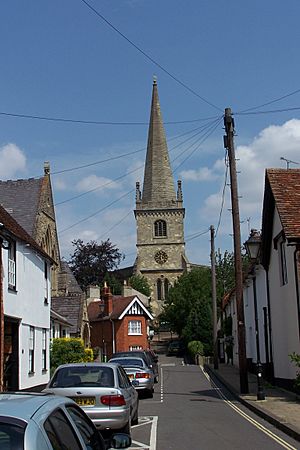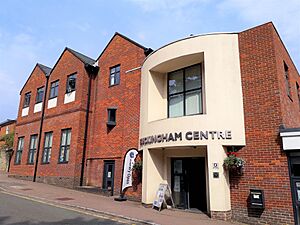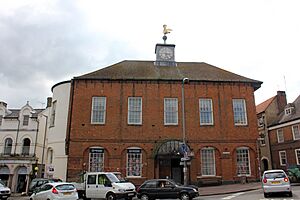Buckingham facts for kids
Quick facts for kids Buckingham |
|
|---|---|
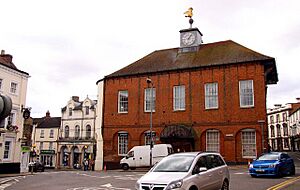 Buckingham Town Hall |
|
| Population | 12,890 {2011 Census} |
| OS grid reference | SP695335 |
| • London | 55 miles (89 km) SE |
| Civil parish |
|
| Unitary authority |
|
| Ceremonial county | |
| Region | |
| Country | England |
| Sovereign state | United Kingdom |
| Post town | BUCKINGHAM |
| Postcode district | MK18 |
| Dialling code | 01280 |
| Police | Thames Valley |
| Fire | Buckinghamshire |
| Ambulance | South Central |
| EU Parliament | South East England |
| UK Parliament |
|
| Website | Buckingham Town Council |
Buckingham is a lively market town in northern Buckinghamshire, England. It is close to the borders of Northamptonshire and Oxfordshire. In 2011, about 12,890 people lived there. The town is about 12 miles (19 km) west of Central Milton Keynes. It is also 19 miles (31 km) south-east of Banbury and 24 miles (39 km) north-east of Oxford.
Buckingham was once the main town, or county town, of Buckinghamshire. This was from the 10th century until the 1700s, when Aylesbury took over.
Today, Buckingham has many restaurants and pubs, like most market towns. It also has a mix of local and national shops. Market days are Tuesday and Saturday. These markets fill Market Hill and the High Street. Buckingham is connected to Neukirchen-Vluyn in Germany and Mouvaux in France as a twin town.
Contents
History
People have lived in the Buckingham area for a very long time. Signs of Roman settlements have been found near the River Great Ouse. One example is a temple south of the A421 at Bourton Grounds. This temple was dug up in the 1960s and dates back to the 3rd century AD. Pottery and old kilns found nearby suggest early Roman pottery making.
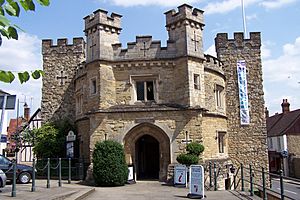
In the 600s, Buckingham was likely founded by a leader named Bucca. He was one of the first Anglo-Saxon settlers. The first settlement was built around a bend in the River Great Ouse. This area is now part of the University of Buckingham. For about 400 years, Buckingham was often fought over by the Saxons and the Danes. In 914, King Edward the Elder and his Saxon army stayed in Buckingham for four weeks. They made the local Danish Viking leaders give up. After this, a fort was built where the Buckingham parish church stands today.
Buckingham is mentioned in the Domesday Book of 1086. This was a big survey of England. The book described Buckingham, including 26 burgesses (important townspeople) and one mill.
The town received its special charter in 1554 from Queen Mary. This made Buckingham a free borough. A borough is a town with its own local government.
A big fire swept through the town centre on March 15, 1725. Many streets, including Castle Street and Market Hill, were destroyed. About 138 homes burned down. The Georgian architecture you see today in these areas was built after the fire. It took a long time for the town to recover. Many buildings are now 'listed buildings' because of their history. This includes Castle House, which is from the 15th century. Buckingham Town Hall is also a listed building from the late 1700s.
The town got a railway connection in 1850. This helped it grow. In 1971, local councils started a big project to expand the town. This included building a bypass road. The population grew from over 5,000 to 9,309 by 1991.
Saint Rumbold
Buckingham is said to be the final resting place of Saint Rumbold. He was a little-known Saxon saint. He is often called St Rumbold today. You can find his name on a local road and in books about him.
Geography
The town is built around its old market place. Many buildings from the 1700s can be seen here. Three main roads cross Buckingham: the A413, the A421 (the southern bypass), and the A422. Capability Brown's famous gardens at Stowe are a major attraction. They are cared for by the National Trust.
There is an old medieval well called St Rumbold's Well. It is on the south side of the old railway line. The well is often dry now.
Buckingham has several areas, or suburbs. These include Mount Pleasant, Page Hill, Bourton, and Lace Hill. Maids Moreton, a village nearby, has now joined with Buckingham's urban area. Other towns close by are Winslow, Bicester, Brackley, and Milton Keynes. Local villages include Padbury and Gawcott. Buckingham is also very close to Stowe, home to Stowe House and Stowe School.
Bourton
Bourton was once a small village, or hamlet, near Buckingham. Its name means 'fortified enclosure' in Old English. Today, Bourton is part of Buckingham. A road and an old mill in the town are still named Bourton.
Bourton was once home to a large house. This house was damaged by Parliamentarian soldiers during the English Civil War. The house is no longer there.
Population
In 2011, the population of the Buckingham built-up area was 12,890. This number included Maids Moreton. The population of the Buckingham civil parish (which includes Lace Hill but not Maids Moreton) was 12,043. The town has continued to grow since 2011. In October 2019, the Town Council estimated the population of its civil parish to be 15,700.
Education
Buckingham is home to the University of Buckingham. This is the oldest of the UK's six private universities. Many of its students come from other countries.
Buckinghamshire Council manages the state secondary schools. The local state secondary schools are the Royal Latin School (a Grammar School) and the Buckingham School (a secondary modern). Stowe School and Akeley Wood School are private schools just outside the town.
There are four primary schools in Buckingham. Buckingham Primary School is a community school. The other three are academies: Bourton Meadow Academy, George Grenville Academy, and Lace Hill Academy.
Industry and Business
Buckingham has several industrial estates and technology parks. These are home to companies working in areas like medicine, electronics, food, and special materials. Companies like Racelogic and Wipac are based here.
Buckingham was also where the Thomas Rickett steam car was made in 1860. This was a very new type of vehicle for its time.
Most shops are in the town centre. You can find many independent stores, cafes, and restaurants, as well as bigger national chains. The Hidden Quarter, mainly on Well Street and Bridge Street, has unique independent shops.
Town Markets
Buckingham's historic street market has been running for over 600 years. It started with special permissions, or Charters, given by Queen Mary in 1554 and King Charles II in 1664.
Street markets are held every Tuesday and Saturday. Traders sell many different things, including fish, fruit, vegetables, bread, and clothes. There is also a flea market every Saturday. This market is held where the town's old cattle pens used to be. It offers antiques, collectibles, and jewellery.
Governance
Buckingham has two levels of local government. These are the parish (town) level and the unitary authority level. The Buckingham Town Council is based at the Buckingham Centre. The Buckinghamshire Council is the larger authority.
Buckingham was an ancient borough for a long time. It became a municipal borough in 1836. The Buckingham Borough Council used to be based at Buckingham Town Hall. In 1974, the borough was replaced by the Buckingham Town Council. In 2020, the larger Aylesbury Vale district council was also replaced. It merged with Buckinghamshire County Council to form the new Buckinghamshire Council.
Transport
Road
Buckingham is at the crossing point of the A413, A421, and A422 roads. A new section of the A421 was built in the early 1980s. This bypasses the town to the south.
Bus
Buses connect Buckingham to Milton Keynes, Winslow, and Aylesbury. The X6 bus runs regularly. The X5 bus links the town to Bedford (through Milton Keynes) and Oxford (through Bicester). Some nearby villages also have bus services on market days.
Canal
The Buckingham Arm of the Grand Junction Canal served Buckingham from 1801. It closed in the late 1800s. A short part of the canal east of the town has been restored.
Rail
Buckingham once had a railway station. It opened in 1850 and closed to passengers in 1964. The closest train stations to Buckingham now are Wolverton and Milton Keynes Central to the east. To the south-west are Bicester North and Bicester Village. The new East West rail link will have a stop at nearby Winslow. This service is expected to start running by the end of 2025.
Leisure and Wellbeing
Sport
Buckingham has two local football teams: Buckingham Athletic F.C. and Buckingham United F.C. There is also a rugby union club, Buckingham RUFC. Moretonville Junior Football Club has teams for younger players. The town also has the Buckingham Town Cricket Club and the Buckingham Hockey Club. Since 2014, Buckingham has hosted a weekly 5 km Parkrun.
The town has public sports facilities. These include the Swan Leisure Centre, which has an indoor swimming pool, a climbing wall, and sports pitches. There are also bowls pitches and tennis courts. Several private golf clubs are near the town.
Culture
Buckingham Old Gaol is the town's museum. It opened in 1993 in the old Gaol building. It also has changing exhibitions and the Tourist Information Centre.
The Chandos Cinema operated from 1934 to 1987. In 2005, a community cinema called the Film Place opened at the university. Live music events are often held at the Radcliffe Centre.
A library is located in the town centre. It is run by Buckinghamshire County Council.
The town has many clubs and groups. These include the Buckingham Society and a large U3A group. There are also music, photography, and arts clubs.
Buckingham holds an annual Charter Fair in October. It starts on the first Saturday after the 11th of the month and lasts for two Saturdays. In the 1800s, it was called the Statute Fair. Sometimes, an ox, sheep, and pig were roasted publicly at the same time.
Tourism
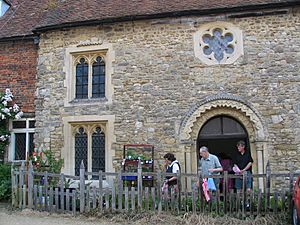
Popular places to visit in Buckingham include the Chantry Chapel and the Buckingham Old Gaol museum. The Sir George Gilbert Scott-designed St. Peter & St Paul Church is also a beautiful sight. The town has many charming Georgian streets. Nearby attractions include Stowe School, Stowe Landscape Gardens, and Silverstone Circuit.
Buckingham has several hotels, such as the Villiers Hotel and White Hart in the town centre. There are also hotels like Best Western Buckingham Hotel and Travelodge on the edge of town.
Healthcare
Buckingham has one GP surgery called The Swan Practice. It also has a community hospital. A minor injuries unit at the hospital closed in 2009. The closest major hospital with an accident & emergency department is in Milton Keynes.
Media
The town is served by the Buckingham & Winslow Advertiser weekly newspaper.
Local radio stations include BBC Three Counties Radio, Heart East, and Greatest Hits Radio Bucks, Beds and Herts. There is also 3Bs Radio, a community station for Buckingham, Bicester, and Brackley.
The town can receive television signals from two transmitters. Residents can choose between Oxford (for ITV Meridian/BBC South) and Sandy Heath (for ITV Anglia/BBC East).
Places of Worship
- St Bernardine's Catholic Church, Buckingham
- Buckingham Evangelical Church
- St Peter and St Paul, Buckingham (Church of England)
- The Salvation Army
- Well Street United Church, Buckingham (Methodist, Baptist and United Reformed Church)
Notable People
Many interesting people have connections to Buckingham:
- George Baldock (footballer)
- Sam Baldock (footballer)
- John Bercow, who used to be the Speaker of the House of Commons
- Gillian Blake (actress)
- Dan Jones (writer)
- Bernie Marsden (guitarist/songwriter with the rock band Whitesnake)
- Robert Maxwell, a businessman and Member of Parliament
- Craig Pickering (athlete)
- George Gilbert Scott (architect)
- Anthony Seldon, Vice-Chancellor of the University of Buckingham
- Browne Willis, a Member of Parliament
Twin Towns
Buckingham has been twinned with Joinville, in France, since 1963.
In 2002, Buckingham also became a twin town with the French town of Mouvaux.
In 2020, Buckingham officially joined with the German town of Neukirchen-Vluyn. This town is also twinned with Mouvaux. So now, Buckingham, Mouvaux, and Neukirchen-Vluyn are all officially twinned.
See also
 In Spanish: Buckingham para niños
In Spanish: Buckingham para niños
- Buckingham (borough)
- Buckingham (UK Parliament constituency)
- Buckingham Palace, a famous building in London, is named after this town.
- Buckingham gave its name to Buckingham Township, Bucks County, Pennsylvania
- Duke of Buckingham
- Duchess of Buckingham



